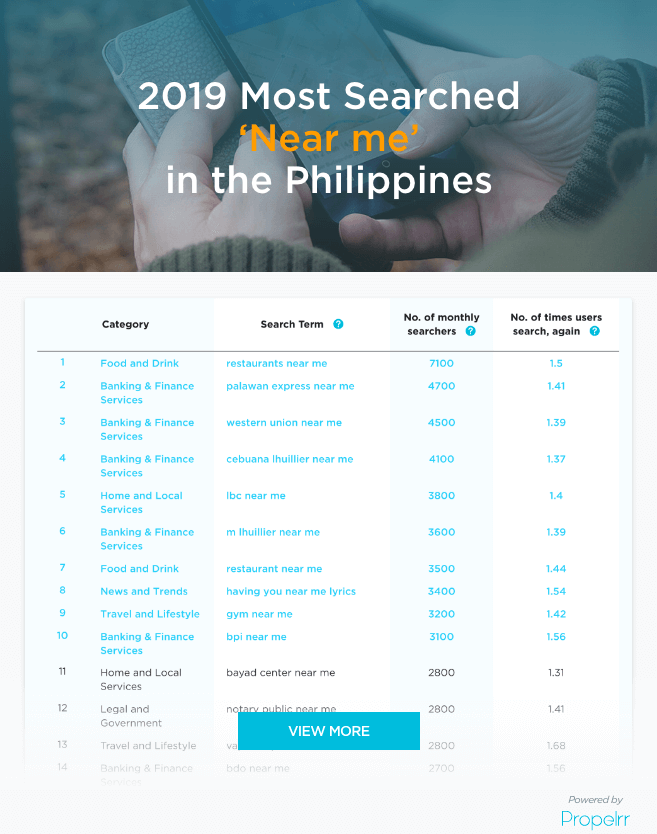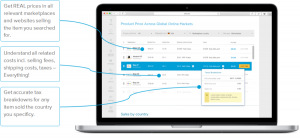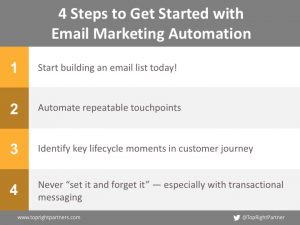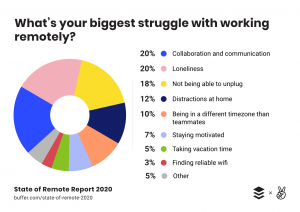What most searched for words and phrases will lead potential customers to your website? Propelrr, a digital marketing agency in the Philippines, presented a case study on the top searched “near me” keywords. This study discusses the importance of having the right keywords to help boost your online visibility.

Keyword research is the process of discovering the terms people use as search queries in search engines and creating quality content using these terms. It is an important digital marketing tool that every marketer should master.
Keyword research gives you an insight into what people look for and what matters to them. By doing a regular keyword search, you could identify topics you can create content on. This will also help you address your audience’s issues and improve customer experience.
What is an SEO keyword?
An SEO keyword, also known as a search query, is a word or a phrase in your online content that allows people to find your page through search engines. Using keywords could help improve your website’s search engine ranking for such keywords. The challenge is in identifying the right keywords and how to optimize content around them.
Keyword research today is not simply using the terms that exactly match search queries. It has become imperative to know the intent behind keywords. Keyword intent is what a person is likely to do when searching for particular keywords. For example, someone who enters the search query “restaurants near me” is likely to visit one very soon. Instead of merely matching keywords in your content with popular search queries, your Web pages should give solutions to searchers. You can verify keyword intent by entering terms on Google and other search engines, and see the results.
What is the importance of keywords?
Keywords are your guide in knowing what your audience is looking for and how you would give them solutions. With the right search keywords, you could drive organic traffic to your Web pages and convert them into subscriptions and/or sales, among others.
Keywords will lead people to your Web pages and guide you on the types of content you should be creating. Only quality content that appeals and is useful to your audience will rank well organically and drive traffic to your pages.
So how do you get started in using keywords to your advantage? By building a comprehensive local search keyword list. A keyword list is your map for creating content for your Web pages and URL structure. Think of it as a sitemap for your website. Begin by listing down your niche markets.
Step 1: Identify your niche market
 Photo Courtesy of sl wong via Pexels
Photo Courtesy of sl wong via Pexels
When it comes to niche markets, your options are almost endless. A niche market is a segment of a larger market with an identity unique from other markets. A niche can further be narrowed down by the particular needs and preferences of the people who comprise it. For instance, a niche market based on psychographics can be redefined into smaller segments based on values, interests, and attitudes.
To succeed, you do not need a lot of markets. You just have to identify a few to master and build a strong and sustainable audience around.
Forbes offers some tips on how to identify your niche market if you have not already:
- Know the activities that you enjoy and are good at.
- Survey your target market to understand their pain points.
- Research on your potential competitors and know if there is a market for your niche.
- Assess the profitability of your potential niche market.
- Test your idea with friends and acquaintances or through A/B testing.
“Remember to remain flexible and continue to make adjustments along the way,” wrote Caroline Castrillion for the Forbes.
Step 2: Research keywords for your niche market
 Photo Courtesy of Canva Studio via Pexels
Photo Courtesy of Canva Studio via Pexels
Once you have identified your niche market, it is time to research keywords for your niche. Niche keywords are market-segment-specific, long-tail keywords usually made up of more than 4-word phrases that people use as search queries. The goal is to avoid highly competitive shorter keywords, which are tougher to rank for. Also, long-tail keywords fetch lower-cost bids on Google Adwords than more popular shorter terms.
Here are some of Keyword research tools you can use:
- Google Keyword Planner. The information from this tool is directly from the largest search engine in the world, making it a top choice for keyword searches. Aside from keywords, you could also see average monthly searches, competition and suggested bid for AdWords.
- Google Correlate. Your keyword list should be perceptive. Google Correlate allows you to see the keywords that are searched for together and search-related phrases. You can expand your keyword list and plan your content calendar better.
- Free Keyword Tool by WordStream. This provides hundreds of keyword ideas on any phrase. The downside is that you will have to browse through a long list.
- Keyword In. This tool combines keywords seamlessly. You can mash up terms and match types such as broad, phrase and exact match.
Step 3: Make sure the keywords have metrics
 Photo Courtesy of Burst via Pexels
Photo Courtesy of Burst via Pexels
After generating a keyword list, your next job is to handpick the keywords to use to optimize your content. You only need those that will bring the most value. You need keywords that have low difficulty and are relevant to your content, can boost traffic and equip you to outrank your competitors.
First, analyze search volume trends. Some keywords are more effective during certain seasons. Holiday keywords are sought-after during the yuletide season. You can review the analytics data of your website to see the monthly keyword trends or use tools such as Google Keyword Planner.
Next, understand the competition in organic searches. One importance of using long-tail keywords is to avoid highly competitive keywords that could hurt your ranking. This may be a tough task if you are in a popular industry. You can use tools that provide information on the organic competition of keywords. The Google AdWords competition metric and Moz Keyword Difficulty percentage could be helpful.
Then assess the keyword value. This means computing the monetary value of a keyword using this simple formula:
(The keyword average monthly search volume x average click-through rate for a top-ranking) x keywords suggested bid in AdWords
The result gives the value of a first page ranking on Google.
Step 4: Bucket your keywords
 Photo Courtesy of fauxels via Pexels
Photo Courtesy of fauxels via Pexels
Keyword bucketing is the process of grouping of keywords categorized based on types, demographics, location, campaign, and other classes. Bucketing can help improve the relevance of keywords and enable you to create cost-effective content and landing pages that boost conversions.
Review your keyword list and pick the keywords that drive the most traffic and conversions. This will be your top-level keyword group. The terms in this bucket should broadly represent your business. For instance, you can use your offerings and products (jackets, sweaters, winter clothing). Then, make smaller and more specific sub-buckets of keywords. The second-level groups may suggest the types, material and other special features of your offerings. You can go as deep as four levels.
Step 5: Build an intent-based keyword list
 Photo Courtesy of Pixabay via Pexels
Photo Courtesy of Pixabay via Pexels
Intent is the purpose behind a search query. It is the “why” behind the keywords entered in search engines. Search intent is a powerful demographic as it points you to the keywords that will likely lead to a conversion. The queries may be to find an answer to a question (informational), to locate a specific website or webpage (navigational) or to conduct a transaction (transactional).
To build an intent-based keyword list, start by jotting down your core keywords. These include your offerings, products, and services. Tip: use the Google-vetted “People also ask” snippets (PAA) which show the queries search engines, like Google, favor for a keyword set. Moz recently reported that PAA snippets are now appearing in 79% of SERPs. PAA snippets will give you an idea of how search engines link topics. You can also use these in optimizing content.
You can use Google’s algorithm to help you build your intent-based list. Do a search and assess the SERPs and the results they generate.
Search engines are today’s Yellow Pages, tour guides and concierge. If people want to know bakeries near them or the contact number of a neighborhood plumber, they simply go online to find out.
It is important for your website to be visible to those who matter. As SEO guru Adam Audette said, “Today, it’s not about ‘Get the Traffic’ — it’s about ‘Get the Targeted and Relevant Traffic.”
Understand the importance of keyword research in creating quality content for your website and in boosting your search engine ranking. Identify your niche market and create keyword buckets that match your market and segments. Dig deep into the intent behind search queries and build an intent-based keyword list that effectively leads people to your business.
Roll up your sleeves and get busy with your SEO game plan!
Digital & Social Articles on Business 2 Community
(12)






